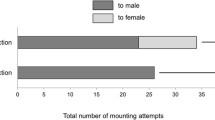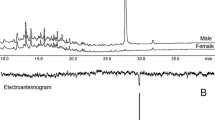Abstract
Adult Sehirus cinctus cinctus emit a volatile secretion from their metathoracic scent glands when tactually stimulated. We identified the volatile components by gas chromatography, high-performance liquid chromatography, and mass spectrometry. The secretion of both sexes contained (1R)-(+)-α-pinene, (1S)-(–)-β-pinene, β-myrcene, (R)-(+)-limonene, and α-terpinolene. Two additional compounds were found in only female secretions: (E)-2-hexenyl acetate and (E)-2-octenal. We also tested the defensive capability of this insect by offering it to various predators. Anoles, starlings, and a killdeer rejected S. c. cinctus after an initial sampling. These findings suggest that the secretion plays a defensive role.
Similar content being viewed by others
REFERENCES
Aldrich, J. R. 1988. Chemical ecology of the Heteroptera. Annu. Rev. Entomol. 33:211-238.
Aldrich, J. R., Carroll, S. P., Oliver, J. E., Lusby, W. R., Rudmann, A. A., Waters, R. M. 1990. Exocrine secretions of scentless plant bugs: Jadera, Boisea and Niesthrea (Hemiptera: Heteroptera: Rhopalidae). Biochem. Syst. Ecol. 18:369-376.
Baker, R., and Walmsley, W. 1982. Soldier defense secretions of the South American termites Cortaritermes silvestri, Nasutitermes species N.D. and Nasutitermes kemneri. Tetrahedron 38:1899-1910.
Blum, M. S. 1981. Chemical Defenses in Arthropods. Academic Press, New York
Boivin, G., and Stewart, R. K. 1982. Attraction of male green apple bugs, Lygocoris communis (Hemiptera: Miridae), to caged females. Can. Entomol. 114:765-766.
Brower, L. P. 1984. Chemical defense in butterflies, pp. 109-137, in R. I. Vane-Wright and P. R. Ackery (eds.). The Biology of Butterflies. Academic Press, London.
Eisner, T., and Grant, R. P. 1981. Toxicity, odor aversion, and “olfactory aposematism.” Science 213:476.
Eisner, T., and Meinwald, J. 1987. Pheromones and sexual selection, pp. 251-269, in G. D. Prestwich and G. J. Blomquist (eds.). Pheromone Biochemistry. Academic Press, Orlando, Florida.
Eisner, T., Kriston, I., and Aneshansley, D. J. 1976. Defensive behavior of a termite (Nasutitermes exitiosus). Behav. Ecol. Sociobiol. 1:83-125.
Froeschner, R. C. 1960. Cydnidae of the Western Hemisphere. Proc. U.S. Natl. Mus. 111:337-680.
Hamilton, J. G. C., Gcough, A. J. E., Staddon, B. W., and Games, D. E. 1985. Multichemical defense of plant bug Hotea gambiae (Westwood) (Heteroptera: Scutelleridae): (E)-2-Hexenol from abdominal gland in adults. J. Chem. Ecol. 11:1399-1409.
Miller, N. C. E. 1971. The Biology of the Heteroptera. E. W. Classey, Hampton, Middlesex, UK.
McCarty, R. 1978. Onychomys leucogaster. Mamm. Species 87:1-6.
McDonald, F. J. D. 1968. Some observations on Sehirus cinctus (Palisot de Beauvois) (Heteroptera: Cydnidae). Can. J. Zool. 46:855-858.
Olagbemiro, T. O., and Staddon, B. W. 1983. Isoprenoids from metathoracic scent gland of cotton seed bug, Oxycarenus hyalinipennis (Costa) (Heteroptera: Lygaeidae). J. Chem. Ecol. 9:1397-1412.
Scales, A. L. 1968. Female tarnished plant bugs attract males. J. Econ. Entomol. 61:1466-1467.
Sites, R. W., and McPherson, J. E. 1982. Life history and laboratory rearing of Sehirus cinctus cinctus (Hemiptera: Cydnidae), with descriptions of immature stages. Ann. Entomol. Soc. Am. 75:210-215.
Smith, R. H. 1963. Toxicity of pine resin vapors to three species of Dendroctonus bark beetles. J. Econ. Entomol. 56:827-831.
Southwood, T. R. E., and Hine, D. J. 1950. Further notes on the biology of Sehirus bicolor (L.) (Hemiptera, Cydnidae). Entomol. Mon. Mag. 86:299-301.
Staddon, B. W. 1979. The scent glands of Heteroptera. Adv. Insect Physiol. 14:351-418.
Whitman, D. W. 1988. Allelochemical interactions among plants, herbivores, and their predators, pp. 11-64, in P. Barbosa and D. Letourneau (eds.). Novel Aspects of Insect-Plant Interactions. John Wiley & Sons, New York.
Whitman, D. W., Blum, M. S., and Jones, C. G. 1985. Chemical defense in Taeniopoda eques (Orthoptera: Acrididae): Role of the metathoracic secretion. Ann. Entomol. Soc. Am. 78:451-455.
Whitman, D. W., Blum, M. S., and Alsop, D. W. 1990. Allomones: Chemicals for defense, pp. 289-351, in D. L. Evans and J. O. Schmidt (eds.). Insect Defenses. State University of New York Press, Albany.
Author information
Authors and Affiliations
Rights and permissions
About this article
Cite this article
Krall, B.S., Zilkowski, B.W., Kight, S.L. et al. Chemistry and Defensive Efficacy of Secretion of Burrowing Bug (Sehirus cinctus cinctus). J Chem Ecol 23, 1951–1962 (1997). https://doi.org/10.1023/B:JOEC.0000006482.12576.90
Issue Date:
DOI: https://doi.org/10.1023/B:JOEC.0000006482.12576.90




